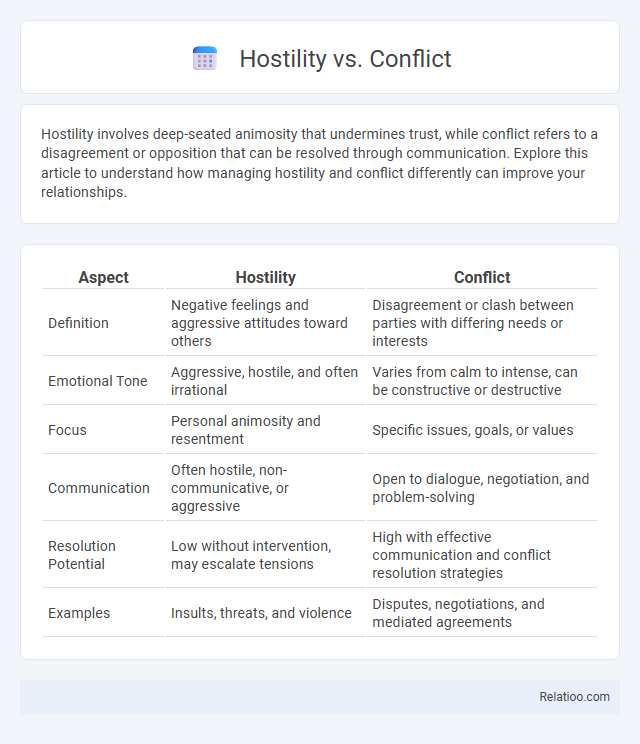Hostility involves deep-seated animosity that undermines trust, while conflict refers to a disagreement or opposition that can be resolved through communication. Explore this article to understand how managing hostility and conflict differently can improve your relationships.
Table of Comparison
| Aspect | Hostility | Conflict |
|---|---|---|
| Definition | Negative feelings and aggressive attitudes toward others | Disagreement or clash between parties with differing needs or interests |
| Emotional Tone | Aggressive, hostile, and often irrational | Varies from calm to intense, can be constructive or destructive |
| Focus | Personal animosity and resentment | Specific issues, goals, or values |
| Communication | Often hostile, non-communicative, or aggressive | Open to dialogue, negotiation, and problem-solving |
| Resolution Potential | Low without intervention, may escalate tensions | High with effective communication and conflict resolution strategies |
| Examples | Insults, threats, and violence | Disputes, negotiations, and mediated agreements |
Understanding Hostility: Definition and Characteristics
Hostility refers to an intense feeling of animosity or opposition, often manifesting through aggressive behavior or negative attitudes. Unlike conflict, which involves a disagreement or clash between parties, hostility carries a deeper emotional charge that can escalate tensions and hinder resolution. Understanding hostility involves recognizing its root causes, such as fear or resentment, and identifying signs like verbal aggression, passive-aggressive actions, or overt hostility to manage your responses effectively.
Defining Conflict: Key Features and Types
Conflict involves a perceived incompatibility of goals, interests, or values between individuals or groups, characterized by communication breakdown, emotional intensity, and behavioral actions. Key features include mutual awareness of opposition, interdependence, and the possibility of resolution through negotiation or mediation. Types of conflict range from interpersonal and intrapersonal to intergroup and organizational, each requiring tailored strategies to manage your specific situation effectively.
Hostility vs Conflict: Core Differences
Hostility refers to intense negative emotions or attitudes often expressed through anger, aggression, or animosity, while conflict denotes a disagreement or clash between parties that may involve differing interests, values, or goals. Hostility can exist without conflict, manifesting as internal feelings or passive aggression, whereas conflict requires an active engagement between individuals or groups. Understanding this distinction is crucial for effective conflict resolution, as addressing emotional hostility demands different strategies than managing the structural elements of a conflict.
Psychological Roots of Hostility
Hostility stems from deep-seated psychological roots such as unresolved trauma, perceived threats, and chronic stress, which differentiate it from general conflict or aggression. Your emotional response may escalate to hostility when underlying fears and past experiences influence your perception of others' actions, intensifying negative feelings beyond mere disagreement. Understanding these psychological triggers is crucial to addressing hostility effectively and reducing its impact on relationships.
Conflict Dynamics: Causes and Progression
Conflict dynamics often stem from underlying causes such as resource scarcity, value differences, and communication breakdowns, triggering escalating tensions between parties. Hostility represents the emotional and attitudinal manifestation of conflict, characterized by distrust, animosity, and aggressive behavior that intensifies discord. Progression in conflict involves cycles of negative interactions where hostility fuels retaliatory actions, deepening misunderstandings and hindering resolution efforts.
Social and Emotional Impact of Hostility
Hostility generates negative social and emotional impacts by fostering mistrust, anxiety, and isolation within interpersonal relationships, often escalating conflicts into long-lasting disputes. Unlike mere conflict, which may involve constructive disagreement and resolution, hostility intensifies emotional distress and damages social bonds, undermining your ability to maintain healthy connections. Managing hostility effectively requires recognizing its signs early and employing empathy and communication strategies to restore social harmony and emotional well-being.
Constructive vs Destructive Conflict
Constructive conflict fosters open communication, promotes problem-solving, and strengthens relationships by addressing issues with respect and collaboration. Destructive conflict escalates tension through hostility, leading to damaged trust, emotional distress, and reduced productivity. Differentiating hostility from conflict is crucial; hostility involves aggressive attitudes and behaviors that hinder resolution, whereas conflict can be managed positively to drive growth and understanding.
Managing Hostility in Interpersonal Relationships
Managing hostility in interpersonal relationships requires recognizing its emotional intensity compared to general conflict, which involves disagreements that may not always escalate to hostility. Effective strategies include active listening, empathic communication, and setting clear boundaries to de-escalate tensions before hostility arises. Understanding the root causes of hostility, such as unresolved anger or perceived threats, enables targeted interventions that foster reconciliation and trust rebuilding.
Conflict Resolution Strategies and Practices
Conflict involves a disagreement between parties that can be addressed through conflict resolution strategies such as negotiation, mediation, and active listening. Hostility represents a deeper level of aggression and negative emotions that can escalate conflicts if not managed properly. Your effective conflict resolution practices should focus on de-escalating hostility by fostering empathy, open communication, and collaborative problem-solving techniques.
Fostering Healthy Interactions: Reducing Hostility and Conflict
Fostering healthy interactions involves understanding the differences between hostility, conflict, and aggression to effectively reduce tension and promote cooperation. Strategies such as active listening, empathy cultivation, and clear communication help transform potential hostility into constructive dialogue and resolve conflicts without escalation. Implementing conflict resolution techniques empowers individuals and groups to manage disagreements, building trust and encouraging collaborative problem-solving.

Infographic: Hostility vs Conflict
 relatioo.com
relatioo.com